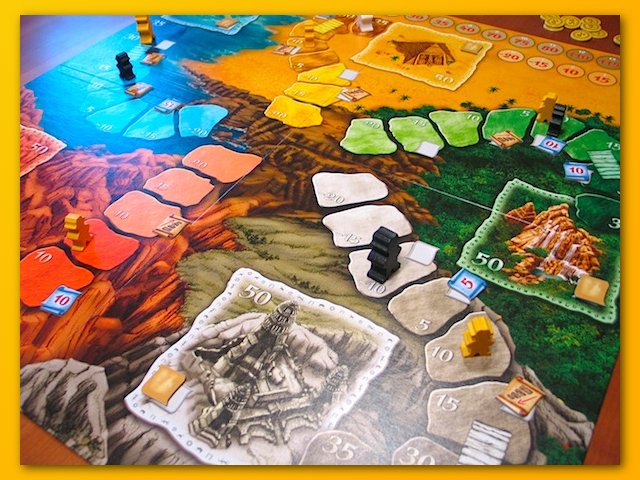
A few months ago I had the opportunity to play Lost Cities: The Board Game. After a long wait on a 2nd print run, I received a copy as a gift and I’m glad to say I finally managed to play it again.
If you’re familiar with the two-player card game Lost Cities, you’ll be quickly up to speed on the board game version. But even if you’re new to both games, the mechanics are simple and you and your family will be enjoying it before you know it.
The game retains the “exploration” theme by having each player represent researchers sent on treks along paths in search of victory points. The board features 5 spiraling paths in unique colors that match the 5 suits in a deck of 100 cards numbered 1-10 (2 copies of each card). As in the card game, players begin adventures by placing like colored cards in front of them. For each card placed, the player advances the appropriate researcher one step along the like-colored path. A player is restricted from placing more than one of their researchers on any single path but is free to start as many paths as desired (one for each suit of cards they have played). You’ll rarely be able to start all 5 researchers so you must decide which adventures to get involved in.
Each placed card must be greater or equal to a previously placed card in that color so you’ll want to start with a low numbered card and grow as slowly as possible so that you can lay down as many cards as possible in that color during the round. As your researcher moves along the steps of the path, he ensures the number of victory points marked on the highest attained step (awarded at the end of the round). Each step on the path is worth points but they start out negative, decrease to zero, and then increasing to 50 points by the end of the path. Because of the inverted point system, you don’t want to start an adventure unless you’re sure you can move that researcher far enough along the path with subsequent card play to advance past the negative point values. There are five paths (5 suits) and you have 4 “regular” researchers and 1 “large” researcher who counts double when awarding points.
If you cannot (or would rather not) play a card on one of your adventures and you don’t want to start a new adventure (lay down the first card of a suit you haven’t already started), you can discard a card to a suited discard pile. Like the card game, you play a card from your hand (or discard) and only then do you pick up a card from one of the suited discard piles (not your own card of course) or draw a card from the single draw deck.
In addition to the point value marked on each step, each path houses several tokens scattered along its length. At the beginning of the round, these tokens (ladders, points, and artifacts) are randomized and scattered along the paths and when a researcher reaches a step containing a token the research can benefit from the type of token present.
Ladder tokens allow the researcher to move this or any other already trekking researcher an additional step on their representative path. Point tokens immediately grant the player the number of points marked on the token. The ladder and point tokens remain on the path for subsequent players to also benefit from it they reach that level along the path. Artifact tokens, however, behave differently. The first researcher to reach the step containing the artifact grants the player possession of the artifact denying it from subsequent players. Artifacts are used for end game scoring.

Near the end of of each path is a bridge and the round ends when any 5 researchers have crossed a bridge or the draw deck is exhausted. Players count their points and exchange their recovered artifacts for markers held until the end of the game. The tokens are shuffled and randomly placed on the steps of the paths, the cards are shuffled, and players score their points from the highest attained step plus any additional points awarded by reaching steps with point tokens. Researchers are placed back in the center of the board and another round begins. A game consists of 3 rounds (i.e. 3 mini-games). The artifact markers obtained throughout the game represent end-game scoring. Players use a scoring chart to find the number of victory points gained (or lost!) depending on how many markers you found during all three rounds. The awarded points drive players to try to find at least some artifacts during the three rounds so that they won’t lose points at game end. However, the more you find the more points you get for each individual artifact. More is better but artifacts are not a single path to victory.
I like the game for what it is. It’s simple to teach and easy to grasp. It’s about the same weight as Ticket to Ride so it sits firmly in the family game genre and provides a nice way to pull in another 2 players into the mechanics presented in the 2-player card game. The ability to play cards equal to or greater than an existing adventure and the additional scoring opportunities provided by the tokens placed on the paths make the game more forgiving than the card game. We usually play with the tokens placed on the paths face-down. This provides a bit of a “what did you find?!” moment the first time somebody reaches the step. This is technically against the rules of placing them face-up. Having them face-down lightens the game even more taking away the knowledge of what paths are “worth going for” but we enjoy the a-ha! moment of finding things along the way more than the “fun” of the additional strategy.
